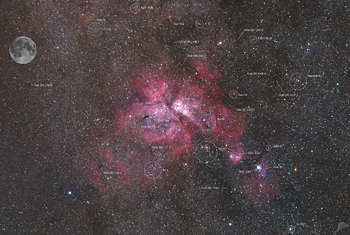 |
CHAMÄLEON + ONJALA OBSERVATORY DeepSky | SITEMAP HOME CHAMÄLEON |
|
 |
|||
| « back to overview Nebulae | Load higher resolution (1800 x 1200 Pixel 3500 x 2300 Pixel) | Object description |

At a distance of between 7500 and 10 000 light years from the solar system, in the constellation of Carina (the keel of the ship), NGC 3372, the Carina Nebula complex, is one of the largest star forming regions in our galaxy. The nebula complex lies in the Sagittarius arm of the Milky Way. As one of the largest HII regions in our Galaxy, the Carina Nebula represents a huge star forming region, similar to the Orion Nebula. It contains several open star clusters, including the Collinder 228, 232 and 234 clusters, Trumpler 14 Trumpler 15 and Trumpler 16, and Bochum 10 and Bochum 11.
The massive stars of the open star clusters in the center of this H-II region emit intense radiation that excites the surrounding gas to glow. Other regions of the nebula, however, contain dark pillars of dust that cover newborn stars. In the Carina Nebula, a battle between stars and dust is going on, which the newly formed stars will win. They produce high-energy radiation and stellar winds that vaporize and dissolve the dusty nurseries of the stars in which they were formed.
 |
With
an extension of more than 300 light years, the Carina Nebula is one of the
largest star-forming regions in the Milky Way and is clearly visible to the
naked eye when the sky is dark. It is only visible from the southern hemisphere
of the Earth. Although the nebula is one of the brightest objects in the night sky - it is much larger and also brighter than the Orion Nebula - it was documented relatively late because of its extremely southern position. Only in the years 1751-1752 Nicolas Louis de Lacaille described it on his voyage to the Cape of Good Hope. He recorded the nebula as Lacaille III.6. The most interesting objects in this region are the star Eta Carinae and "Herschels Keyhole Nebula". More information and pictures of these two objects are shown here. « Labeled version with object names and a size comparison to the moon |
 |
 |
 |
 |
 |
 |
 |
| Sun | Moon | Solar System | DeepSky | Widefield | Miscellaneous | Spec. Projects |